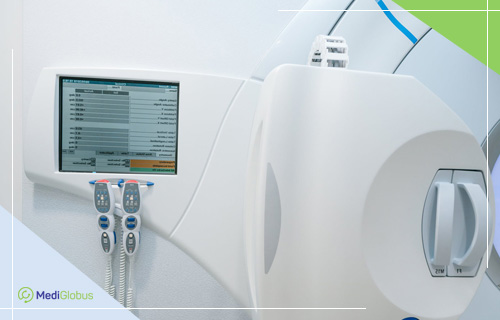1. Lung cancer therapy |
2. Surgical interventions |
3. Targeted therapy |
4. Radiation exposure to the tumour |
5. Terminal lung cancer therapy |
6. Leading clinics |
The choice of treatment methods for lung cancer is determined by various factors. Among them are the stage of the malignant process and the type of tumour. The best results in fighting the disease can be achieved by surgery. Chemotherapy, radiation, and taking targeted and immune medications can improve its effectiveness. Read more about the most effective ways to fight this disease in our article.
Reading time:
Lung Cancer: Definition and Treatment
Lung cancer is a malignant tumour that develops from the cells of this organ. It is the most common type of cancer. More than a million new cases of the disease and about 921,000 deaths from it are registered worldwide each year. Mostly it is diagnosed in patients over 50 years old. It affects men more often than women.
There are two varieties of this oncopathology:
Small cell lung cancer (SCLC) is the most aggressive and fastest-growing of all types of malignancies. It is closely related to smoking. SCLC rapidly metastasizes to many parts of the body. It is detected in 10-15% of patients.
Non-small cell lung cancer (NSCLC) is diagnosed in 85-90% of all cases of the disease. It has a more favourable prognosis than small cell tumours. NSCLC is divided into adenocarcinoma, squamous cell and large cell cancers.
Patients with non-small cell lung cancer are treated with surgery, chemo, radiation and targeted therapy or a combination of these methods. For patients with small cell tumours, radiation and chemotherapy are used. After a comprehensive treatment program, the overall 5-year survival rate for NSCLC is 26% and 7% for SCLC. This figure varies for different stages of the disease and is as follows:
Stage 1 – 92%-68%
Stage 2 – 60%-53%
Stage 3 – 36%-13%
Stage 4 – 10%-1%
Learn more about lung cancer treatment abroad from MediGlobus coordinators. We will help you to choose the right clinic and doctor, as well as arrange the medical trip.
Surgery for lung cancer
Surgery is the key method of dealing with lung cancer. It gives the best prognosis for survival. The type of surgery varies according to the type and stage of the malignancy.
Lung tumours of grade zero (adenocarcinoma “in situ”) are removed by wedge resection. During this operation, the surgeon excises the tumour along with a small section of the lung. He then examines the tissue under a microscope. This is to make sure that the tumour is completely excised. The efficiency of this operation is more than 95%.
In stage 1 lung cancer, patients also undergo wedge resection of the cancerous lesion. Other operations such as segmentectomy (removal of the segment of the lung where the tumour is located) or lobectomy (removal of the affected lobe of the lung) may also be performed. Some patients require additional resection of part of the bronchi. The effectiveness of treatment can be as high as 90%.

Among the main surgical forms to fight stage 2 lung cancer are lobectomy and pulmonectomy – removal of one lung. Lymph nodes in which cancer may be detected are also excised.
If the presence of malignant cells is confirmed, the patient is prescribed adjuvant chemotherapy. It is necessary to destroy residual cancer cells in the body.
The standard protocol for treating lung cancer with chemo is four to six courses. The interval between injections of antitumor drugs is 3 to 4 weeks.
The procedure is often combined with radiotherapy. This option is more effective, but also more aggressive. After such a treatment program, about half of patients with stage 2 disease pass the 5-year survival threshold.
Grade 3 lung cancer surgery is usually performed after a course of chemoradiotherapy. This allows doctors to reduce the size of the tumour and perform a more gentle resection of the organ – lobectomy. After surgery, the patient may be given another course of chemotherapy to remove the remaining cancer foci. Foreign countries perform minimally invasive removal of lung lobes. Often, the VATS technique – video-assisted lung part removal through small incisions – is used. This significantly reduces the trauma of the operation and the recovery time after it.
If the tumour has significantly spread into the organ, a pulmonectomy will be necessary. Extended lung resection is also performed in conjunction with this procedure. It implies the removal of muscles, nerves, and blood vessels that are close to the neoplasm. If the malignant process is “transferred” to the bones of the spine, these structures are resected as well. Afterwards, the spinal column is repaired with implants, metal rods and screws.
Also in stage 3 lung cancer, muscles, bones, and other tissues of the chest wall are removed. After that, the chest wall is reconstructed using artificial bone or titanium plates. The average efficiency of treatment is 26%.
Targeted therapy for lung cancer

Targeted drugs are among the most advanced oncology therapies. They have a targeted effect on cancer cells, preventing them from dividing. Healthy tissues are not damaged during this type of therapy, which means that the patient suffers from no significant side effects.
Targeted therapy is indicated for some patients with non-small cell lung tumours with EGFR gene mutations. Advanced and metastatic cancers that respond well to these drugs.
Doctors predominantly use monoclonal antibodies (e.g., Bevacizumab). These drugs damage the endothelium of the blood vessels of the tumour, preventing it from “feeding” and growing. They are often combined with chemotherapy.
The efficacy of targeted drugs for lung cancer is 75%. After diagnosis, most patients with metastatic tumours with this therapy survive for three or four years, and a few patients live much longer.
Radiation therapy for lung cancer
Radiotherapy for lung cancer involves the use of high-energy X-rays to destroy a malignant tumour or prevent its growth. Radiation can be external or internal. In the second case, radioactive materials (grains, plates, capsules) are placed directly inside the neoplasm. However, more often external irradiation is used.
Radiotherapy for lung cancer is usually given 5 days a week for five to seven weeks. If the goal of treatment is palliative care (controlling and “alleviating” the symptoms of the pathology), irradiation lasts 2-3 weeks.
This involves the daily use of low doses of radiation. This helps to protect healthy cells in the area of radiation exposure.

Can stage 4 lung cancer be cured?

In stage 4 lung cancer, it is not customary to talk about a complete cure. The fight against a terminal tumour is aimed at relieving symptoms, improving the patient’s quality of life, and prolonging it. Non-surgical methods are used for this purpose – targeted therapy, chemotherapy, and targeted drugs.
Stage 4 lung cancer is usually inoperable. It metastasizes to distant organs, mostly affecting the brain, spine, and liver. Surgical intervention in this case will not give the desired result.
Palliative treatment of advanced lung cancer is carried out in parallel with the main treatment program for the disease. It involves the use of various medical procedures that allow to alleviate the physical condition of the patient and improve the emotional background.
The prognosis for survival in lung cancer with metastases is unfavourable. Only 2-10% of patients pass the 5-year threshold of life.
Where can I get treatment for lung cancer abroad?
Liv Hospital Vadistanbul
Koç University Hospital
Sourasky Medical Center
Uniclinic of Navarra
Assuta Medical Center
Anam Clinic
Resume
The most effective treatment for lung cancer is surgery. Surgery removes the tumour completely and reduces the risk of recurrence. It involves resection of the affected part of the lung.
Lung removal for cancer is considered one of the most effective methods at stages 2 and 3 of the disease. Tumours of stages 0 and 1 do not need a total resection (pulmonectomy). In these cases, removal of a small part, segment or lobe of the lung is performed. To achieve remission, surgery is combined with radiation, chemotherapy, and targeted drugs.
In inoperable cancer, conservative methods are used: chemotherapy, immune and targeted therapy. The 5-year survival rate for terminal lung tumours is 2-10%.
Patients prefer Turkish, Israeli, Spanish, and South Korean clinics for lung cancer treatment. Among the medical centres in these countries, the most popular are: Liv, Koç, Teknon, Ichilov, Assuta, Severance, SoonChunHyang, Anam, and the University Hospital of Navarra.





